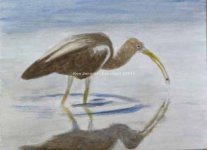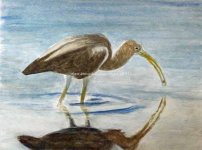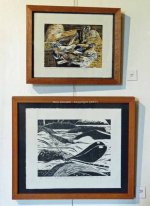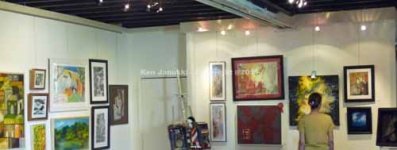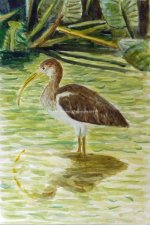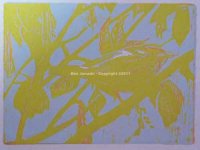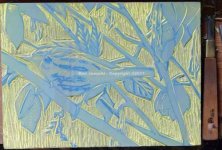-
Welcome to BirdForum, the internet's largest birding community with thousands of members from all over the world. The forums are dedicated to wild birds, birding, binoculars and equipment and all that goes with it.
Please register for an account to take part in the discussions in the forum, post your pictures in the gallery and more.
You are using an out of date browser. It may not display this or other websites correctly.
You should upgrade or use an alternative browser.
You should upgrade or use an alternative browser.
revivingKensArt (2 Viewers)
- Thread starter solitaryVSong
- Start date
More options
Who Replied?solitaryVSong
Well-known member
Thanks all. I once had a wonderful encounter with a Golden-winged Russ where my wife and I had just sat down to rest and a male landed only about 10 feet away and 6 feet up. Sad to say I wasn't drawing birds then. But the memory is still strong.
One thing that really struck me in the juvenile White Ibis was the speckling on the neck almost like that of many shorebirds, a rich combination of ochres and browns. So I'd like to paint that.
But most of the photos I took show much of the bird in shadow so you can't see that color. In any case I did one small watercolor based on a photo of the bird in shadow and am showing it. I see many mistakes but the only one I think I'll fix is to tone down whatever it has in its mouth so it's not so dark.
I think I'll go back and try to do another that shows off the neck a bit more. That will be based on my field sketches and memory. Just can't get that neck out of my head.
One thing that really struck me in the juvenile White Ibis was the speckling on the neck almost like that of many shorebirds, a rich combination of ochres and browns. So I'd like to paint that.
But most of the photos I took show much of the bird in shadow so you can't see that color. In any case I did one small watercolor based on a photo of the bird in shadow and am showing it. I see many mistakes but the only one I think I'll fix is to tone down whatever it has in its mouth so it's not so dark.
I think I'll go back and try to do another that shows off the neck a bit more. That will be based on my field sketches and memory. Just can't get that neck out of my head.
Attachments
solitaryVSong
Well-known member
phil baber
Clipped Wing

Super stuff Ken. And another water-snail bites the dust!
solitaryVSong
Well-known member
So nice to see all these sketches Ken, it shows what happens when an artist goes a-birding, and sets the scene for the work to come from genuine field experience.
Mike
Thanks Mike. Your line about 'a-birding' reminds me of one of my all-time favorite birding book titles, 'A-birding on a Bronco' by Florence Merriam in 1896. Sad to say I've never read it.
I'm enclosing a couple of photos from my group show. One of the two linocuts, and another of my wife Jerene perusing the art.
Attachments
timwootton
Well-known member
Cuts look super, Ken - really lovely. So does Jerene - just a tad distant and, I'm sure, from her worst side. Keep us up to date on sales, please? (surripticiously, if the taxman's a watch'n).
phil baber
Clipped Wing

They look great on a wall Ken. Jerene makes a great installation.
solitaryVSong
Well-known member
Thanks all. As many of you know it's nice to see your work up, framed and on a gallery wall after seeing it in less than ideal conditions in whatever functions as your studio.
I'm including another small watercolor sketch of the juvenile White Ibis. This one does a better job of getting the variation in the neck color though the spatterdock at the back tells me I need to continue to work on vegetation. No surprise there!
I'm including another small watercolor sketch of the juvenile White Ibis. This one does a better job of getting the variation in the neck color though the spatterdock at the back tells me I need to continue to work on vegetation. No surprise there!
Attachments
solitaryVSong
Well-known member
like how you have softened the reflection here
I really don't much like reflections Colleen. They often seem just way too stiff, like something copied from a photo, except in the hands of a master like Tim. So I think I'm better off if I just sketch them in.
The big problem with me in this one is trying to remember how big the spatterdock is. I sketched the bird but not the vegetation. In my photos it looks as big as the bird. But that seems unlikely and I know telephoto lenses can magnify objects in the background. But without any sketches it's very hard for me to determine how large the individual plant leaves really should be. So this is a bit of fudging............
phil baber
Clipped Wing

Another fine Januski piece. Subtle and strangely, though very pleasingly, alluring.
solitaryVSong
Well-known member
timwootton
Well-known member
Missed this ibis watercolour earlier - gorgeous translucency to the image - beautiful bird. Love it.
phil baber
Clipped Wing

Ha! Can't wait to see this develop Ken!
solitaryVSong
Well-known member
Ha! Can't wait to see this develop Ken!
Me too Phil! Not exactly as though I know where it's going. These types of prints are always an adventure.
Colleen, yes you're right about how reduction prints work. You keep cutting away the colors you've printed. The difficulty with that is that you're pretty much stuck with what you've already done. So I've already printed an edition of 18 for this and it's mainly yellow and blue as in the proof I showed. If I decided I wanted to get back the white of the paper I'd be completely out of luck. The white disappeared after I printed the first color. So basically you have to make good guesses about what you want to keep, how it's going to develop, etc. But they're only guesses!
I'm including a photo of the block itself. The raised area where it's not yellow is the area I still have to carve and print, with at least 4-5 additional colors if things go as planned.
The thing I really like about reduction linocuts is that, at least for me, there's no way to get bogged down in detail. So I think it keeps the abstract part of me happy.
I hope one day to be able to paint this way. But I'm not there yet.
Attachments
Similar threads
- Replies
- 8
- Views
- 772
Users who are viewing this thread
Total: 3 (members: 0, guests: 3)




